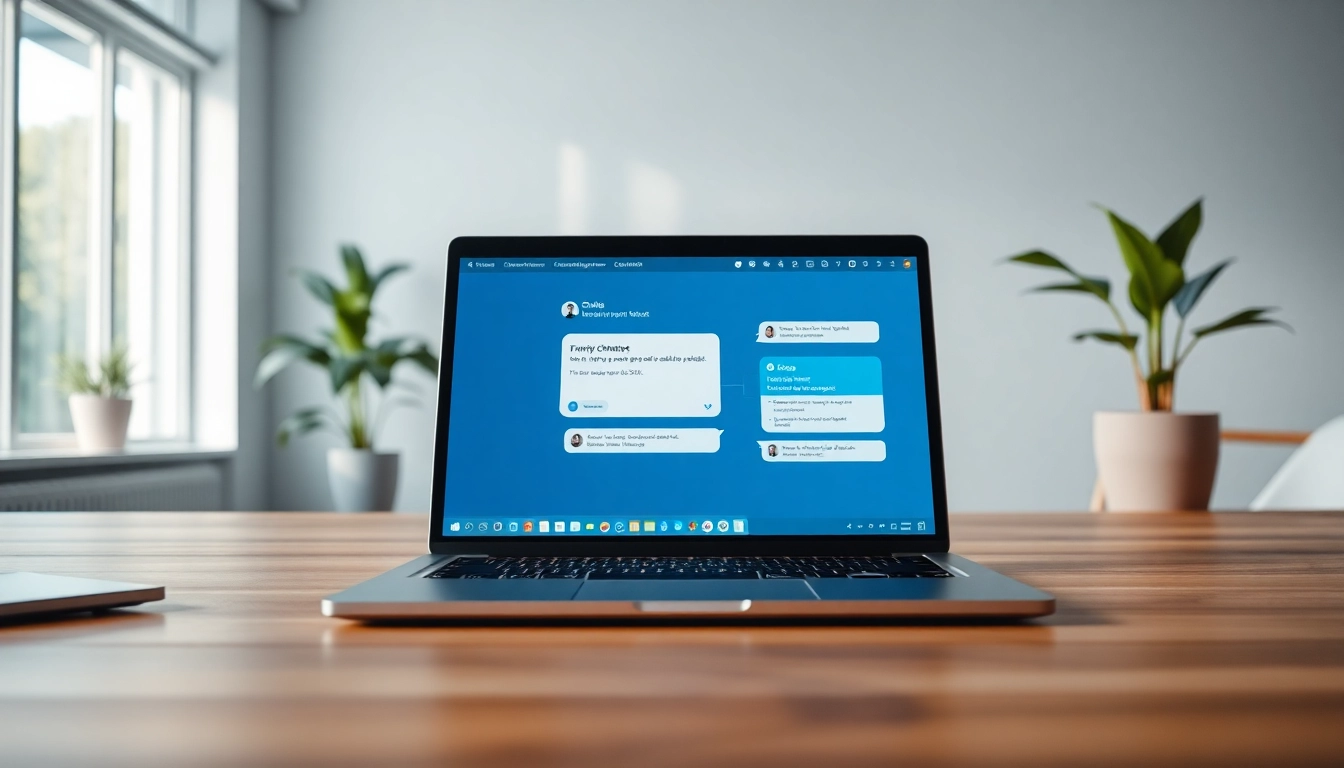Understanding the ChatGPT Chatbot Technology
The advent of artificial intelligence has reshaped many aspects of business communication, and at the forefront of this revolution is the chatgpt chatbot. This technology leverages sophisticated machine learning techniques to engage users in natural and meaningful conversations. Understanding how ChatGPT operates is crucial for businesses looking to enhance interactions with consumers, streamline workflow processes, and optimize user experience.
What is ChatGPT and How Does it Work?
ChatGPT, developed by OpenAI, is a state-of-the-art language processing AI model that can understand and generate human-like text. It is built upon the GPT architecture, where “GPT” stands for Generative Pre-trained Transformer. The model learns from extensive datasets encompassing diverse topics, allowing it to perform exceptionally in generating coherent responses that sound almost human.
ChatGPT works by predicting the next word in a sequence based on the context provided by the user. It applies techniques like supervised learning and reinforcement learning from human feedback to improve its responses continuously. As users interact with the chatbot, it learns and adapts to provide more relevant and accurate answers over time.
Key Features of ChatGPT Chatbots
One of the significant advantages of deploying ChatGPT chatbots in business contexts is their dynamic feature set. Here are some of the key features:
- Natural Language Processing: ChatGPT chatbots use NLP to comprehend user inquiries accurately and respond in a conversational manner.
- Contextual Awareness: They can track context within a conversation, allowing for more fluid interactions and replies that reference prior discussions.
- Multi-Turn Conversations: ChatGPT excels in handling complex queries that require multiple exchanges, ensuring users receive comprehensive support without friction.
- Customizability: Businesses can tailor the behavior and responses of the chatbot to align with brand voice and customer service standards.
- Integration Capabilities: ChatGPT can integrate seamlessly with existing CRM systems, websites, and messaging platforms, contributing to a holistic engagement strategy.
Benefits of Using a ChatGPT Chatbot for Businesses
Implementing a ChatGPT chatbot offers numerous advantages, making it an invaluable asset for businesses. Here are some primary benefits:
- 24/7 Availability: Unlike human agents, chatbots can operate round-the-clock, enabling businesses to assist customers at any time of day, thus enhancing customer satisfaction.
- Cost Efficiency: Automating customer support reduces the need for a large workforce, leading to significant savings in operational costs.
- Scalability: Businesses can handle increased user inquiries without a corresponding increase in staffing, making it easier to scale operations during peak times.
- Consistency: ChatGPT chatbots provide consistent answers to customer queries, ensuring uniformity in customer service across all interactions.
- Data Collection and Insights: Chatbots can gather user data and feedback, providing businesses with valuable insights that can drive product development and customer engagement strategies.
Implementing ChatGPT Chatbots in Your Strategy
Identifying Use Cases for ChatGPT Chatbots
To maximize the benefits of ChatGPT chatbots, businesses must strategically select use cases that align with their objectives. Common use cases include:
- Customer Support: Chatbots can manage common inquiries, troubleshoot issues, and guide customers through various processes.
- Sales and Lead Generation: Automating initial customer interactions can help identify leads and streamline the sales funnel.
- Appointment Scheduling: Chatbots can facilitate booking appointments and sending calendar reminders, enhancing operational efficiency.
- Product Recommendations: By analyzing customer behavior and preferences, chatbots can suggest relevant products, improving upsell and cross-sell opportunities.
Steps to Integrate ChatGPT Chatbots Effectively
Integrating ChatGPT chatbots involves several steps to ensure successful deployment:
- Define Objectives: Clearly outline what you hope to achieve with the chatbot, such as improving customer satisfaction or increasing sales.
- Choose the Right Platform: Select a reliable platform that supports ChatGPT integration, ensuring compatibility with your business systems.
- Design Conversational Flows: Create user-centric conversational flows that address common queries and provide intuitive navigation.
- Test and Optimize: Conduct thorough testing to identify any potential issues or miscommunications, refining the chatbot’s responses based on feedback.
- Monitor Performance: Use analytics to track the chatbot’s effectiveness over time, making adjustments for continuous improvement.
Common Pitfalls to Avoid with ChatGPT Deployment
While deploying ChatGPT chatbots can significantly enhance business operations, there are common pitfalls to be mindful of:
- Lack of Personalization: Failing to tailor the chatbot’s responses to specific user needs can lead to frustration. Personalization should be prioritized to engage users effectively.
- Poorly Defined Use Cases: Implementing a chatbot without clear objectives can result in wasted resources. Ensure that every interaction is purposeful.
- Neglecting Human Oversight: While chatbots are capable, they are not infallible. Always have a process in place for escalating complex issues to human agents.
- Inadequate Testing: Insufficient testing before launch can result in negative user experiences. Rigorous testing is essential to iron out any glitches.
Measuring the Success of Your ChatGPT Chatbot
Key Performance Indicators for Chatbot Effectiveness
To assess the impact of your ChatGPT chatbot, it’s crucial to define key performance indicators (KPIs) that align with your business objectives. Common KPIs include:
- Response Accuracy: Measuring how accurately the chatbot answers user inquiries helps gauge its effectiveness in providing relevant information.
- User Engagement: Tracking metrics like conversation length and interaction frequency can reflect user satisfaction and engagement levels.
- Resolution Rate: This indicates the percentage of user issues that the chatbot resolves without the need for human intervention, essentially showcasing the chatbot’s capability.
- Customer Satisfaction Scores: Gathering feedback through surveys post-interaction can provide valuable insights into user satisfaction.
- Conversion Rates: For chatbots in sales contexts, tracking how many interactions lead to conversions is crucial to understanding their financial impact.
Analyzing User Interactions and Feedback
Regularly analyzing user interactions and feedback is vital for continuous improvement. By reviewing chat logs, you can identify trends in user queries and any recurring issues that arise. Feedback mechanisms, such as post-chat surveys, can also help glean insights into user experience. It’s essential to establish a loop of collecting data, analyzing it, and implementing improvements.
Improving Chatbot Responses Over Time
Continuous enhancement of the chatbot responses is paramount for maintaining its relevance and efficiency. This can be achieved through:
- Regular Updates: Continually update the chatbot’s knowledge base with new information, changes in products, or services to ensure it delivers current responses.
- Training with Real Interactions: Utilize actual user interactions to train the chatbot further, refining its understanding of context and nuance in conversations.
- User Behavior Analysis: Review user interactions that led to misunderstandings or frustrations to refine the bot’s conversational designs.
Advanced Features of ChatGPT Chatbots
Customization Options for Specific Industries
One of the compelling advantages of ChatGPT chatbots is their ability to customize responses and interactions for specific industries. Different sectors—such as healthcare, travel, retail, or finance—can tailor chatbots to reflect the necessary terminologies, regulatory requirements, and customer expectations:
- Healthcare: Chatbots can provide medical information and appointment scheduling, with a focus on privacy and compliance with regulations.
- Travel: Chatbots can assist with bookings, provide travel information, and handle customer queries related to itineraries.
- Retail: Retail businesses can utilize chatbots for inventory checks, product recommendations, and handling customer assistance.
- Finance: Chatbots can aid customers in managing accounts, providing investment guidance, and answering transactional queries.
Scalability and Performance Enhancements
Scalability is a significant consideration when choosing to implement a ChatGPT chatbot. As businesses grow, their customer support needs may change dramatically. Key strategies for ensuring scalability include:
- Load Balancing: Implementing load balancers helps distribute user inquiries evenly, maintaining performance levels even during high traffic.
- Cloud Integration: Utilizing cloud services allows for dynamic scaling based on demand, ensuring the chatbot can handle varying interaction levels seamlessly.
- Performance Monitoring: Regular, robust performance monitoring can identify bottlenecks and facilitate proactive enhancements, ensuring smooth operations.
Troubleshooting Common ChatGPT Chatbot Issues
While ChatGPT chatbots are powerful tools, they can encounter challenges that require troubleshooting. Here are some common issues and their solutions:
- Misinterpretation of Queries: Users may phrase questions in unexpected ways. Continuous training using diverse phrasing can improve comprehension.
- Bot Unavailability: Issues with the backend or server can temporarily suspend operations. Regular system health checks and robust backup mechanisms can prevent downtime.
- Stale Responses: If users frequently receive outdated information, regularly update the database and retrain the model with fresh data.
- User Frustration: If users are unhappy with interactions, consider user feedback and implement changes that enhance the bot’s efficacy in addressing needs.
Future Trends in ChatGPT Chatbot Development
AI Innovations on the Horizon
As technology advances, the future of ChatGPT chatbots appears promising. Emerging innovations may include:
- Emotional Intelligence: Future chatbots may incorporate emotional intelligence capabilities, allowing them to understand and respond to users’ emotional states better.
- Voice Interaction: The ability for chatbots to handle voice queries will provide a more natural mode of interaction, appealing to users who prefer speaking over typing.
- Multimodal Interfaces: Chatbots may evolve to incorporate multiple forms of input, such as text, voice, and visual cues, creating comprehensive interaction platforms.
User Expectations and Market Dynamics
As technology evolves, so do user expectations. Customers now demand intuitive interactions that are quick, efficient, and informed. To meet these demands, businesses must:
- Stay Updated: Keeping abreast of user expectations and industry standards is essential for maintaining competitiveness.
- Prioritize User Experience: Focusing on designing intuitive interfaces and seamless user journeys will enhance satisfaction levels.
Preparing for the Future of Chatbots in Business
To ensure sustained success in chatbot implementation, businesses should focus on:
- Regular Training: Ensure the chatbot model is continually being trained with user data to improve its engagement capabilities.
- Cross-Functional Teams: Collaborate among different departments, such as IT, customer service, and marketing, to create a comprehensive perspective on user needs.
- Feedback Loops: Establish processes to regularly collect and review user feedback to inform ongoing improvements in chatbot services.



